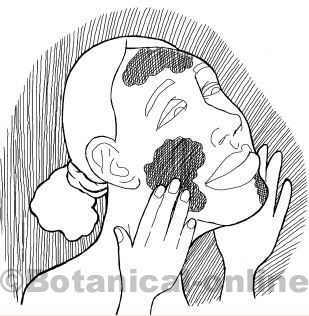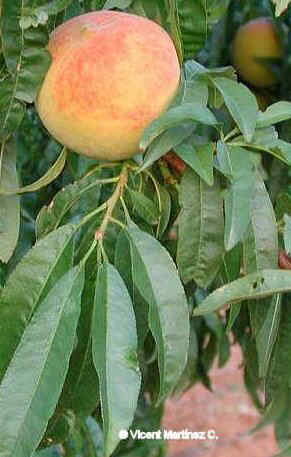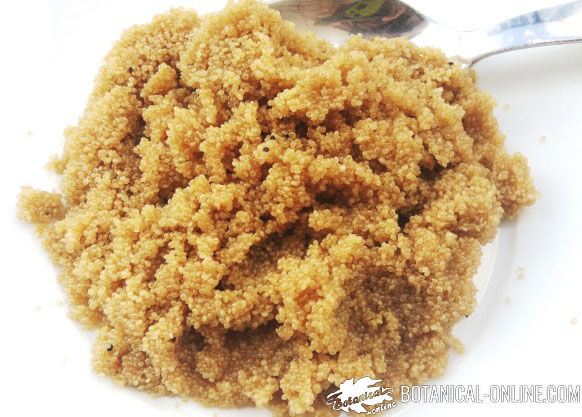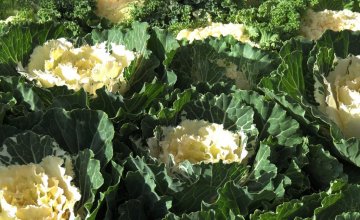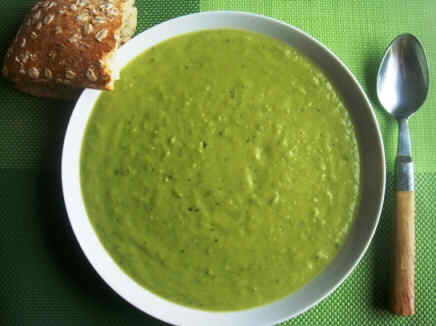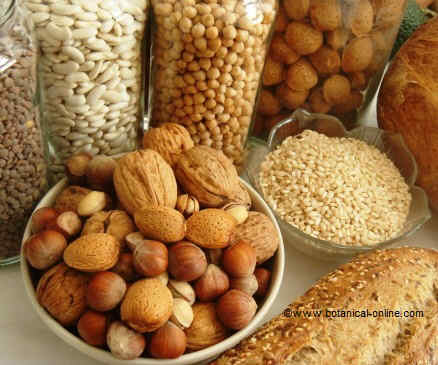Contents
- 1 Benefits of chocolate
- 1.1 MEDICINAL AND EDIBLE PROPERTIES OF CHOCOLATE
- 1.2 Cocoa, the food of the Gods
- 1.3 What does cocoa bring us?
- 1.4 Chocolate helps us feel better
- 1.5 Chocolate contains alkaloids with exciting properties
- 1.6 Antioxidant properties of pure cocoa
- 1.7 Pure cocoa for heart and cardiovascular health
- 1.8 Cocoa for intelligence
- 1.9 Chocolate and Nobel Prize study
- 1.10 Pure cocoa for diabetes
- 1.11 Chocolate, a very energetic food
- 1.12 Chocolate consumption and happiness
- 1.13 RECOMMENDED CHOCOLATE AMOUNT
- 1.14 How much cocoa should be taken to make a profit?
- 1.15 What kind of chocolate is best?
- 1.16 Chocolate as a good remedy for the skin
- 2 Contraindications of chocolate
- 2.1 Is cocoa suitable for diabetes and obesity?
- 2.2 How much sugar does chocolate have?
- 2.3 What is the best chocolate for diabetics?
- 2.4 Is chocolate fattening, or is it a myth?
- 2.5 Chocolate for digestion and liver problems
- 2.6 Pure cocoa and its oxalate content
- 2.7 Chocolate for Constipation?
- 2.8 Chocolate and migraine
- 2.9 Is chocolate a natural food?
- 2.10 Is chocolate the food of youth?
- 2.11 NUTRITIONAL VALUE OF CHOCOLATE
- 2.12 Composition of cocoa powder
- 2.13 Does chocolate produce acne?
- 2.14 Pure chocolate: It is recommended to eat little, but often…
Benefits of chocolate
MEDICINAL AND EDIBLE PROPERTIES OF CHOCOLATE
Cocoa, the food of the Gods
Cacao (Theobroma cacao) is a very important tropical tree in Mesoamerican culture. There is a legend that Hernán Cortés was thought to be god Quetzalcoatl, who gave the cacao to the men, reason why the natives did not offer resistance before the new invaders.
Its scientific name Theobroma cacao comes from “Theos” (=God) and “broma” (= Food), because Linnaeus wanted to give it a botanical name in reference to the importance that this plant had for the native Americans, who considered it the Food of the gods.
What does cocoa bring us?
Cocoa is rich in fats (40-50%), fiber, magnesium, potassium, manganese, zinc and B vitamins.
What stands out most about cocoa is that it is a very antioxidant food due to its richness in flavonoids; And stimulating, by the presence of the theobromine alkaloid.
Chocolate helps us feel better
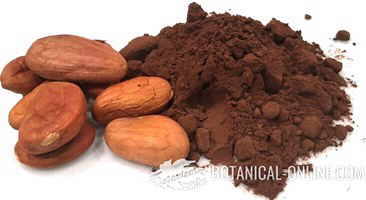
Photo of seeds of pure cocoa and cocoa powder
Why does chocolate make us feel good? Chocolate is a food whose ingestion produces a sense of well-being in the body.
This occurs because this food contains a number of components with euphoric and stimulant properties. Among them, stands out phenylethylamine, a component that, in fact, belongs to the family of amphetamines. Phenylethylamine acts in the brain triggering a state of euphoria and emotional well-being.
This is why people who are accustomed to eating chocolate feel the need to ingest this food in those times when they are not feeling well, when they are sad; when they feel emotionally distressed; because they have lost the couple; because they feel deceived, because depressed, etc.
For this reason, at certain times of the year, such as fall and winter, many people unconsciously eat chocolate to break free from autumn or winter depression.
Chocolate contains alkaloids with exciting properties
In addition to phenylethylamine, cocoa is rich in stimulant alkaloids, such as caffeine and theobromine. Alkaloids also present in plants such as coffee, tea, mate, guarana, orange and lemon.
These alkaloids excite, stimulate the nervous system, making us more active and alert against external stimuli, increase heart rate and favor elimination of urine.
Prolonged and abundant use of them can lead to overexcitation, insomnia and gastritis. However it must be said that the content in these alkaloids is higher in coffee or tea than in chocolate (see composition table)
Antioxidant properties of pure cocoa
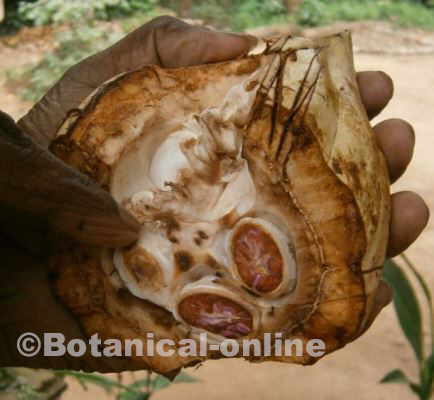
Photo of freshly harvested cacao where the seeds are observed. The cocoa is always allowed to ferment, because in this process is when they produce their aromatic components
More recent studies maintain that pure cocoa is an excellent antioxidant food, which protects us from the damage of free radicals on the body. These antioxidants would be adequate to prevent the degeneration of the cells of the body, responsible for premature aging and the appearance of numerous diseases.
The chemical study of the fruits and seeds of cocoa reveals the existence of more than 30 components with potent antioxidant properties, among which are flavonoids such as quercetin, quercitrin, epicatechins, rutin; Acids, such as caffeic, ferulic, ascorbic or p-coumaric acid or other components such as caffeine or cyanide.
Due to its flavonoid richness, pure cocoa has an antioxidant power comparable to that of fruits, sometimes exceeding its content.
In vitro studies, it has been proved that pure cocoa powder has superior antioxidant activity to that of famous powdered superfoods like acai, blue and red blueberries and pomegranate. In addition, it exceeded in content in total flavonoids to all the previous ones, with remarkable difference.
All this leads to conclude to the people who carry out these studies that chocolates rich in cocoa, such as those containing 70% pure cocoa, maintain a good amount of these components, which gives them some interesting properties for health.
Pure cocoa for heart and cardiovascular health
Pure cocoa has many flavonoids and it is a potent antioxidant, with properties to improve heart health. We must not forget that these components become part of the cocoa paste or cocoa butter when processing the seeds of the cocoa fruits.
Studies have shown that taking pure cocoa helps to decrease hypertension, atherosclerosis, reduce bad cholesterol and maintain good levels of HDL (“good” cholesterol).
Therefore, pure cocoa helps reduce cardiovascular risk, preventing the onset of heart disease or the development of certain cancers (framing their consumption within a healthy diet and habits).
It should be taken into account that chocolate is an energy food, so it is recommended to compensate with some type of physical exercise to avoid having a negative impact on weight.
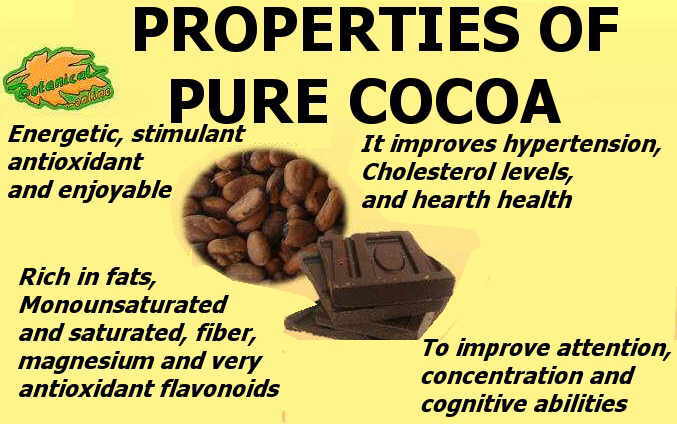
Summary with the main nutritional properties of cocoa and its benefits when included in a healthy diet.
Cocoa for intelligence
Chocolate has been shown to have properties to stimulate cognitive abilities, so it can be a good ally in situations that require a lot of mental attention or concentration.
It is very common for students in exams, oppositions or with much stress to resort to chocolate as an energetic, pleasant and stimulating food.
 Cocoa is an energetic and stimulating food that many students use during testing times.
Cocoa is an energetic and stimulating food that many students use during testing times.
Chocolate and Nobel Prize study
There is an anecdotal study published in 2012, which found that the most consuming countries of chocolate were the most Nobel Prize winners.
Specifically, per capita consumption of chocolate from 23 countries is related to the number of Nobel laureates received by these countries. The result was that countries that consume more chocolate have more Nobel Prizes, which does not mean that chocolate is the cause, but it is a curious fact.
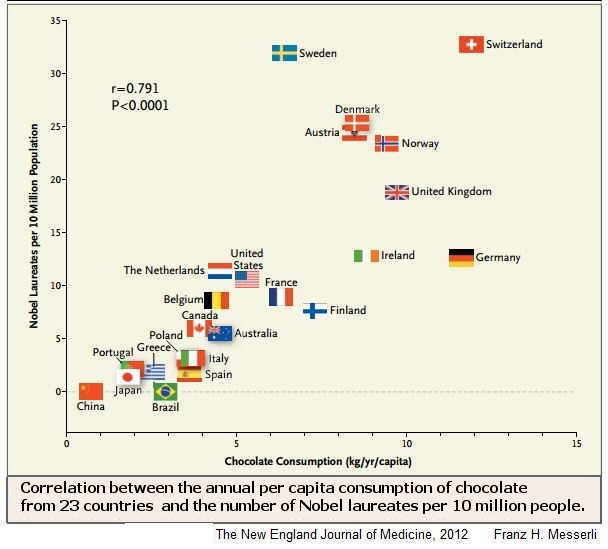
Correlation between the annual per capita consumption of chocolate from 23 countries and the number of Nobel laureates per 10 million people.
Pure cocoa for diabetes
Chocolate is a food often banned for people with diabetes because of its content in calories, fats and added sugars. But the truth is that pure cocoa has properties that can be beneficial, so proper consumption of pure cocoa is not at odds with a healthy diet for diabetes.
Eating pure chocolate, and combining it with a healthy diet and exercise, is totally healthy for diabetics. Even some studies have pointed out that pure cocoa appears to improve insulin resistance, which occurs in obesity and type 2 diabetes.
People with diabetes should eat dark chocolate, with very few added sugars, and consume it in moderate portions.
Chocolate, a very energetic food
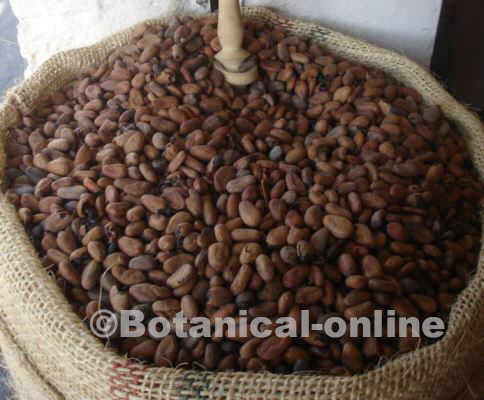
Photo of criollo cocoa seeds ready for sale
Chocolate is a very energetic food because it is rich in vegetable fat (40-50%).
The type of fat that contains the cocoa is mainly monounsaturated and saturated, with very low percentage of polyunsaturated fats.
In addition to the calories from cocoa butter, you must add the calories from the sugar in it.
Pure cocoa is very bitter and practically can not be eaten if it is not sweetened, so in the confection of chocolate large amounts of sugar that can reach almost 50% of the composition are used.
At other times other starches are used as thickeners, such as corn flour, wheat flour, carob, etc. All this makes commercial chocolate an extremely energetic food. A simple chocolate of about 40 g contains more than 200 calories.
The calorie richness of chocolate can be very advantageous in certain situations: People who perform sports require a very high caloric expenditure, so they can normally use this food to keep their energies constant. Climbers, soldiers on difficult missions, astronauts can make use of this energy reserve at some point in need. A chocolate bar can help you regain strength in these situations.
Similarly, a portion of chocolate in an unusual and moderately used way can help children, youth, adults, and the elderly stay active when they are engaging in any ongoing physical activity.
Chocolate consumption and happiness
Finally it can be said that chocolate is a food that makes us feel good for psychological reasons. There is a custom to give children chocolates or chocolate cakes for birthdays, special parties or as a reward for rewarding their successes, such as when they behave well or get good grades.
This food is associated with positive stimuli so that, unconsciously, the ingestion of food with chocolate produces a return to the pleasant moments of childhood or life.
For this same reason chocolates are also given to the elderly on special occasions. In general there is a clear association between chocolate and good times.
RECOMMENDED CHOCOLATE AMOUNT

How much chocolate and what type should be eaten to make it beneficial?
How much cocoa should be taken to make a profit?
There is no amount of beneficial chocolate, but studies evaluate benefits when consuming cocoa between 1 and 4 times a week, without having to consume it every week.
It should be noted that the same studies indicate that the amount of chocolate that should be eaten should be very small or moderate to avoid that the harmful effects of excess of this food on weight gain can outweigh the benefits.
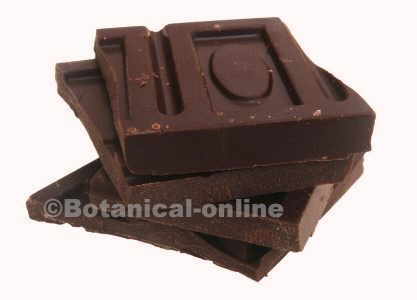
Chocolate photo
The addition of milk to chocolate lowers the concentration of these principles and makes it less antioxidant. It appears that milk proteins bind to antioxidants and make it difficult to absorb them.
On the other hand, cacao can also be eaten in preparations such as mole or molli, a mixture of spices that Mexican cuisine usually uses in their kitchen.
What kind of chocolate is best?
Pure chocolate is the one that contains more flavonoids and components with antioxidant properties and which should be eaten to obtain the benefits mentioned in the article.
* See: How to buy a pure chocolate
Chocolate as a good remedy for the skin
Chocolate is very useful remedy externally applied in the performance of massages with therapeutic properties. The use of these massages facilitates the drainage of the deep and superficial layers of the skin, being suitable in the treatment of cellulite, dryness, spots on the skin, providing brighter appearance because it has exfoliating, moisturizing and invigorating properties.
Woman applying a chocolate mask on the face. Drawing by courtesy of ©Dibujosparapintar.com |
The chocolate masks, very rich in linolin, applied to the face can moisten the skin, increasing the moisturizing of it, which favors the treatment of dry skin which is responsible for the appearance of numerous wrinkles.
How to make a chocolate mask |
| Ingredients:– 100g cocoa powder – 1 spoonful of olive oil – 3 spoonfuls of milk cream Preparation: – Mix 100 g of cocoa powder with a spoonful of olive oil. – Add milk cream at the same time as it is removed until a thick cream is formed. How to apply it? Apply it in the form of a mask for half an hour on the face. To remove it, clean your face with cold |
Cocoa is used for making skin care creams, both cleansing creams, as oily skin creams, mixed skin creams or creams for dry skin.
It has also been seen that the use of this food in the massages can help improve the state of the joints of people suffering from osteoarthritis or arthritis.
Contraindications of chocolate
Is cocoa suitable for diabetes and obesity?
Most chocolates that can be found in supermarkets contain a high amount of added sugars and low cocoa percentage, as well as fats (often of poor quality, coming from coconut, palm or palm kernel). Because of its composition, these products are totally contraindicated in diabetics and obese.
How much sugar does chocolate have?
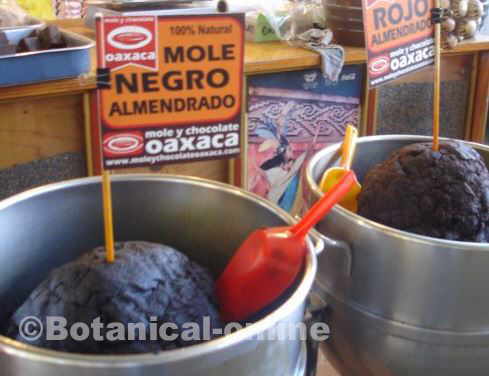
Photo of mole in a market in Oaxaca, Mexico. Cocoa can be eaten in sauces
For example, in 2 squares of chocolate (30gr) are 15gr of sugar, a very high amount for diabetics, which also comes with a considerable amount of fat (10gr).
The same amount of sugar is provided by a whole large apple, which also has 0 fats and provides much more satiety.
What is the best chocolate for diabetics?
The best chocolate for diabetics and obese is pure chocolate. In 20 g of dark chocolate 85% (1 square of the big ones) are 5 gr of sugar (3 times less than the ordinary chocolate) and 10gr of fats (the same amount as milk chocolate).
Due to their low sugar content, very pure chocolates (70% or higher black cocoa) are recommended, but in moderation, because in addition to the beneficial components of pure cocoa, they also conserve more fat.
Is chocolate fattening, or is it a myth?
Chocolate is appetizing and tasty, in a few bites you can eat a lot of sugar and fat without giving us the feeling of overeating. Normally, we will always consume a little more. In the end, we exceed in the amount that should be eaten a food so dense in energy.
Containing more or less sugar, cocoa is a food rich in fats, therefore we should always keep in mind the moderation when consuming this type of food. A recommended intake would be about 20 grams 1 to 4 times a week, without having to take it every week. Do not forget that chocolate is a food with many calories and that it can contribute to obesity if not eaten very sparingly.
The high caloric power of chocolate makes this food an option not suitable for those who are predisposed to gain weight, who are obese or overweight or are on a diet to lose weight.
Chocolate for digestion and liver problems
Its richness in fat makes chocolate much more difficult to digest than other foods lighter or with less fat. Chocolate slows the digestion, or what is the same, its high fat content delays the gastric emptying because the stomach must release them little by little to the intestine so that they emulsify correctly with the bile.
This is an additional work for the liver, which is forced to digest this amount of fat. Chocolate is not suitable for people who have a problem related with the liver (gallstones, biliary insufficiency, etc.).
Pure cocoa and its oxalate content
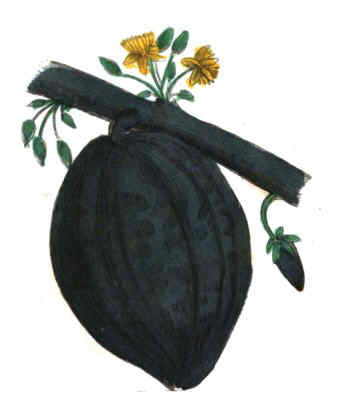
Drawing of fruit and flowers of cacao
Pure cocoa is rich in , components that decrease the intestinal absorption of iron, calcium and other divalent minerals. However, the amount consumed does not result in a significant or significant decrease in these nutrients.
As a precaution, it is recommended that people with anemia and osteoporosis remove foods rich in iron and calcium from these mineral thieves (calcium and iron).
As a precaution, people with anemia and osteoporosis are advised not to mix the iron- and calcium-rich foods of these mineral thieves (foods containing oxalates such as cocoa). If this is not possible (for example, by mixing milk with cocoa), the effect of oxalates can also be compensated by adding more calcium to the diet (by adding more foods rich in calcium or iron).
* More information: Oxalate content of pure cocoa
Chocolate for Constipation?
The cocoa seeds, from which the chocolate is obtained, are very rich in tannins that give it its bitter taste.
Tannins are very astringent components and thus help to promote constipation. Therefore, in small quantity chocolate – especially black and bitter – could constipate, but when consumed in greater quantity, it is laxative because of its fat content.
Chocolate and migraine
Chocolate contains phenylethylamine, a biogenic amine (found in other foods, such as in cheese) that if not properly metabolized, can produce migraine.
People with DAO deficiency (Diamine Oxidase enzyme) may experience migraine or migraine after eating too much chocolate, especially when combined with other foods containing biogenic amines such as cheeses, fish, sausages, wine, meats, crustaceans, tomatoes, and spinach.
Therefore, eating chocolate can increase headache in people who usually have migraine attacks, as some experts consider that they are due, for the most part, to a DAO enzyme deficiency (consult a doctor).
Eating chocolate in the evening or at night is not very convenient for children or adults with enuresis problems, since it can contribute to these people wetting the bed.
Is chocolate a natural food?
The natural word has many connotations. If we understand that natural are those that come directly from plants without having undergone a process of elaboration, strictly speaking, you can not consider chocolate as a natural food.
Chocolate is a fermented and elaborated product, in its composition different ingredients like cinnamon, vanilla, ginger, or chili come in.
This is not to say that chocolate is not a healthy food. Chocolate, eaten in moderation, can contribute its beneficial properties to the organism, as long as those people for whom it is not convenient dispense with it, as we have seen previously.
Is chocolate the food of youth?
Nor should chocolate be exalted as an “ideal food” and recommended as the most nutritious food for youth, which is not true since it encourages an exaggerated consumption of this food that is responsible for a phenomenon of addiction to it and a substitute for other nutritious foods and that could be more appropriate.
NUTRITIONAL VALUE OF CHOCOLATE
The following is the nutritional composition of the chocolate, which is the product made mainly with the cocoa paste, and therefore rich in fats:
| Nutritional composition of chocolate per 100g. | |||
No sugar | With azúcar | with milk | |
| Water | 1, 30 g | 0,50 g | 1, 30 g |
| Calories | 522 Kcal | 505 Kcal | 513 Kcal |
| Fat | 55, 30 g | 34, 2 g | 30, 7 g |
| Protein | 10, 30 g | 3,90 g | 6,9 g |
| Carbohydrates | 28, 30 g | 59,6 g | 59, 2 g |
| Fiber | 15, 4 g | 5,5 g | 3, 4 g |
| Potassium | 833 mg | 290 mg | 385 mg |
| Phosphorus | 417 mg | 147 mg | 216 mg |
| Iron | 6, 32 mg | 2,76 mg | 1, 39 mg |
| Sodium | 14 mg | 16 mg | 82 mg |
| Magnesium | 310 mg | 113 mg | 60 mg |
| Calcium | 74 mg | 24 mg | 191 mg |
| Copper | 2, 1 mg | 0, 574 mg | 0, 385 mg |
| Zinc | 4, 01 mg | 1, 50 mg | 1, 38 mg |
| Selenium | 7,5 mg | 2,8 mg | 3, 9 mg |
| Manganese | 1, 918 mg | 0, 494 mg | 0, 299 mg |
| Vitamin C | 0 mg | 0 mg | 0, 4 mg |
| Vitamin A | 98 UI | 20 UI | 185 UI |
| Vitamin B1 (Thiamin) | 0, 080 mg | 0, 020 mg | 0, 079 mg |
| Vitamin B2 (Riboflavin) | 0, 167 mg | 0, 240 mg | 0, 301 mg |
| Vitamin B3 (Niacin) | 1, 114 mg | 0, 670 mg | 0, 324 mg |
| Vitamin B6 (Pyridoxine) | 0, 095 mg | 0, 043 mg | 0, 042 mg |
| Vitamina B9 (Folic acid -) Folacin | 7 mcg | 3 mcg | 8 mcg |
| Vitamin E | 1, 230 mg | 1, 190 mg | 1, 240 mg |
Composition of cocoa powder
Cocoa powder has different nutritional properties than chocolate. Mainly it has a lower fat content:
| Nutritional composition of pure cocoa powder per 100g. | |
| Water | 3 g |
| Calories | 220 Kcal |
| Fat | 13,10 g |
| Protein | 18,10 g |
| Carbohydrates | 58,30 g |
| From these; sugars | 1,76 g |
| Fiber | 29,8 g |
| Potassium | 2.509 mg |
| Phosphorus | 728 mg |
| Iron | 15,32 mg |
| Sodium | 14 mg |
| Magnesium | 476 mg |
| Calcium | 111 mg |
| Zinc | 6,37 mg |
| Vitamin C | 0 mg |
| Vitamin A | 0 UI |
| Vitamin B1 (Thiamin) | 0,110 mg |
| Vitamin B2 (Riboflavin) | 0,46 mg |
| Vitamin B3 (Niacin) | 2,4 mg |
| Vitamin B6 (Pyridoxine) | 0,095 mg |
| Vitamin E | 0,118 mg |
| Folic acid | 32 mcg |
Does chocolate produce acne?
There are also false opinions about chocolate, such as the one that says it produces acne or is responsible for the appearance of cavities.
In this last aspect, the speed with which the chocolate dissolves in the mouth, together with the action of the tannins on the bacterial plaque, suggests that dark chocolate is less responsible for caries than sweets, buns, sugary drinks or other goodies that accompany cocoa.
Pure chocolate: It is recommended to eat little, but often…
Perhaps the best option, as the latest studies seem to advise, is a very reduced but more frequent consumption of chocolate, better if it is pure. But we must ask ourselves before starting this practice: Who dares to eat a single square of chocolate a day?
![]() More information on cocoa and chocolate
More information on cocoa and chocolate

